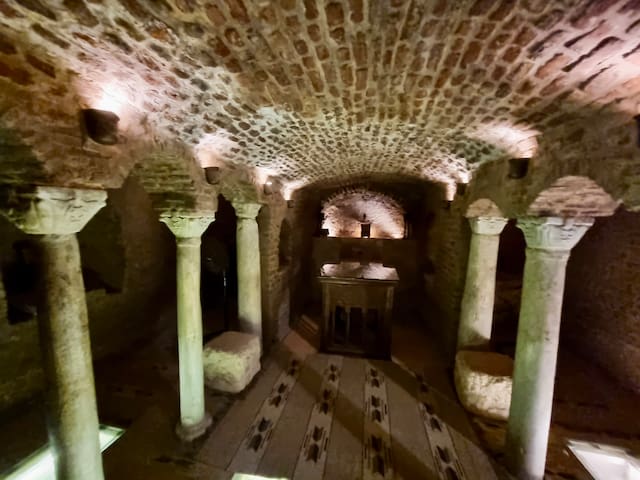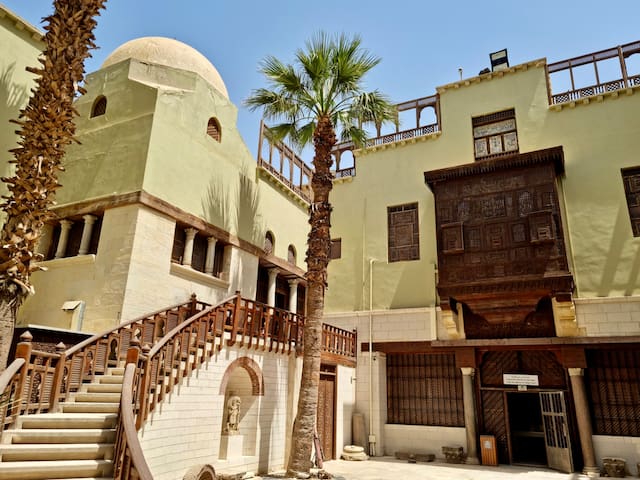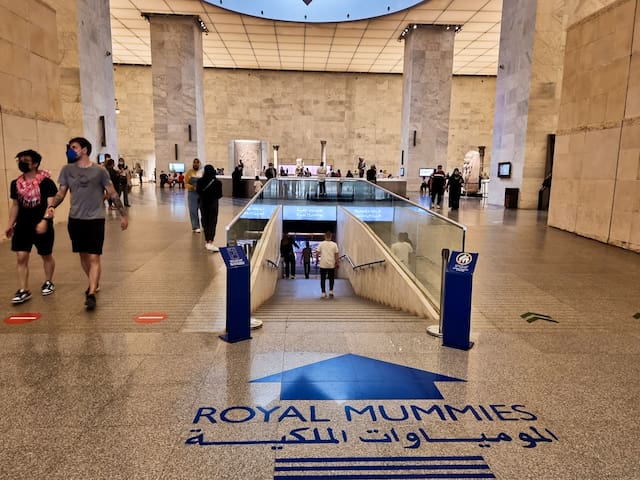Sightseeing
The Hanging Church, also known as the St. Virgin Mary's Coptic Orthodox Church, is a significant historical and religious site in Old Cairo. It is called the "Hanging Church" due to its location above the gatehouse of the ancient Roman fortress of Babylon. The church dates back to the 7th century and has undergone several renovations and restorations over the centuries.
The church is accessed through a narrow passage that leads to a flight of 29 steps, which gave the church its original name, the "Staircase Church." The church's interior is notable for its wooden ceiling, which is designed to look like Noah's Ark, as well as its ornate marble pulpit and beautifully carved screens. It also contains a number of important religious icons and artifacts, including a 14th-century painting of the Last Supper.
In addition to its religious significance, the Hanging Church is also an important cultural and historical site, reflecting Egypt's rich and diverse heritage. It is located in the heart of Old Cairo, a UNESCO World Heritage site, and is surrounded by other important landmarks and attractions, including the Coptic Museum, the Ben Ezra Synagogue, and the Mosque of Amr ibn al-As.
29 lokalinvånare rekommenderar
Den Hängande Kyrkan
The Hanging Church, also known as the St. Virgin Mary's Coptic Orthodox Church, is a significant historical and religious site in Old Cairo. It is called the "Hanging Church" due to its location above the gatehouse of the ancient Roman fortress of Babylon. The church dates back to the 7th century and has undergone several renovations and restorations over the centuries.
The church is accessed through a narrow passage that leads to a flight of 29 steps, which gave the church its original name, the "Staircase Church." The church's interior is notable for its wooden ceiling, which is designed to look like Noah's Ark, as well as its ornate marble pulpit and beautifully carved screens. It also contains a number of important religious icons and artifacts, including a 14th-century painting of the Last Supper.
In addition to its religious significance, the Hanging Church is also an important cultural and historical site, reflecting Egypt's rich and diverse heritage. It is located in the heart of Old Cairo, a UNESCO World Heritage site, and is surrounded by other important landmarks and attractions, including the Coptic Museum, the Ben Ezra Synagogue, and the Mosque of Amr ibn al-As.
The Fortress of Babylon is a historic fortress located in the heart of Cairo, Egypt. It was constructed by the Romans in the 1st century AD, and later rebuilt and modified by various Islamic rulers throughout history. The fortress served as a defensive structure for the city, and played a pivotal role in many historic battles and sieges.
The fortress is named after the nearby Babylonian fortress that was captured by the Persians in 525 BC. The name is also associated with the old Pr-Hapi-n-Iwnw (Nile house of Heliopolis), which was the deity's residence in Heliopolis city; Habi was the Nile's god. The Fortress of Babylon is also known as Qasr el Shamee, or the candles palace, due to the illuminated candles that were placed on its towers at the beginning of each month to trace the path of the sun.
Within the fortress's perimeter are six Coptic churches, a convent, and the Coptic Museum. The churches date back to the 4th and 5th centuries AD, and are believed to have been built on the site of an earlier Christian community. The Coptic Museum is home to a vast collection of Coptic art and artifacts, including ancient manuscripts, textiles, and icons. It provides an insight into the rich cultural and religious heritage of Egypt's Coptic Christian community.
Today, the Fortress of Babylon is a popular tourist attraction and a significant part of Egypt's cultural heritage. Visitors can explore the fortress's towers, walk along its walls, and admire its ancient architecture and historic significance.
Fortress of Babylon
The Fortress of Babylon is a historic fortress located in the heart of Cairo, Egypt. It was constructed by the Romans in the 1st century AD, and later rebuilt and modified by various Islamic rulers throughout history. The fortress served as a defensive structure for the city, and played a pivotal role in many historic battles and sieges.
The fortress is named after the nearby Babylonian fortress that was captured by the Persians in 525 BC. The name is also associated with the old Pr-Hapi-n-Iwnw (Nile house of Heliopolis), which was the deity's residence in Heliopolis city; Habi was the Nile's god. The Fortress of Babylon is also known as Qasr el Shamee, or the candles palace, due to the illuminated candles that were placed on its towers at the beginning of each month to trace the path of the sun.
Within the fortress's perimeter are six Coptic churches, a convent, and the Coptic Museum. The churches date back to the 4th and 5th centuries AD, and are believed to have been built on the site of an earlier Christian community. The Coptic Museum is home to a vast collection of Coptic art and artifacts, including ancient manuscripts, textiles, and icons. It provides an insight into the rich cultural and religious heritage of Egypt's Coptic Christian community.
Today, the Fortress of Babylon is a popular tourist attraction and a significant part of Egypt's cultural heritage. Visitors can explore the fortress's towers, walk along its walls, and admire its ancient architecture and historic significance.
The church's architectural style is an excellent example of the basilica-style churches that were prevalent during the early Coptic era, with three aisles separated by columns or piers. The nave is topped by a wooden roof, while the aisles are covered with barrel vaults. The church's exterior is adorned with a series of blind arches and is constructed of limestone blocks that were reused from earlier structures.
In addition to the crypt, the church also contains a number of historically significant relics and artworks, including a 13th-century iconostasis, a pulpit made of white marble, and a number of ancient icons and frescoes that have been preserved for centuries. It has been an important pilgrimage site for Christians for centuries, and its historical significance and religious importance make it a popular destination for tourists and visitors to Cairo.
St Sergius and St Bacchus Church
Mari GergesThe church's architectural style is an excellent example of the basilica-style churches that were prevalent during the early Coptic era, with three aisles separated by columns or piers. The nave is topped by a wooden roof, while the aisles are covered with barrel vaults. The church's exterior is adorned with a series of blind arches and is constructed of limestone blocks that were reused from earlier structures.
In addition to the crypt, the church also contains a number of historically significant relics and artworks, including a 13th-century iconostasis, a pulpit made of white marble, and a number of ancient icons and frescoes that have been preserved for centuries. It has been an important pilgrimage site for Christians for centuries, and its historical significance and religious importance make it a popular destination for tourists and visitors to Cairo.
The Coptic Museum in Cairo, Egypt, is home to the world's largest collection of Coptic artifacts and artwork, with around 15,000 objects on display. Coptic monuments in the museum showcase a unique blend of Egyptian, Greek, Roman, Byzantine, and Ottoman styles, reflecting the historical and cultural evolution of Egypt from ancient to Islamic times.
The museum was established in 1908 by Marcus Simaika Pasha, a Coptic historian and philanthropist, to preserve and showcase the rich cultural heritage of the Coptic Orthodox Church. The collection includes a diverse range of objects such as stonework, woodwork, metalwork, textiles, and manuscripts, including the Nag Hammadi Library, which contains important early Christian Gnostic texts.
The museum is divided into different sections based on the medium of the objects, and it also features a library, a conservation laboratory, and a lecture hall. The building itself is an architectural masterpiece, designed by the renowned architect Marcel Dourgnon in the early 20th century, blending traditional Egyptian and European styles.
Overall, the Coptic Museum is a must-visit destination for those interested in the art, history, and culture of Egypt, offering a glimpse into the fascinating world of the Coptic Orthodox Church and its influence on Egyptian society over the centuries.
15 lokalinvånare rekommenderar
Koptiska museet
3 Mari GergesThe Coptic Museum in Cairo, Egypt, is home to the world's largest collection of Coptic artifacts and artwork, with around 15,000 objects on display. Coptic monuments in the museum showcase a unique blend of Egyptian, Greek, Roman, Byzantine, and Ottoman styles, reflecting the historical and cultural evolution of Egypt from ancient to Islamic times.
The museum was established in 1908 by Marcus Simaika Pasha, a Coptic historian and philanthropist, to preserve and showcase the rich cultural heritage of the Coptic Orthodox Church. The collection includes a diverse range of objects such as stonework, woodwork, metalwork, textiles, and manuscripts, including the Nag Hammadi Library, which contains important early Christian Gnostic texts.
The museum is divided into different sections based on the medium of the objects, and it also features a library, a conservation laboratory, and a lecture hall. The building itself is an architectural masterpiece, designed by the renowned architect Marcel Dourgnon in the early 20th century, blending traditional Egyptian and European styles.
Overall, the Coptic Museum is a must-visit destination for those interested in the art, history, and culture of Egypt, offering a glimpse into the fascinating world of the Coptic Orthodox Church and its influence on Egyptian society over the centuries.
The National Museum of Egyptian Civilization in Cairo stands out as a must-visit destination for tourists seeking a deep and insightful exploration of Egypt’s rich history. Here’s why I highly recommend it:
1. Comprehensive Collection: The museum houses an extensive and diverse collection of artifacts spanning various periods of Egypt’s civilization. From ancient artifacts to more recent historical items, visitors get a holistic view of the country’s evolution.
2. Interactive Exhibits: The museum employs modern and interactive exhibit techniques, making the learning experience engaging and memorable. Visitors can immerse themselves in the narratives of each display, enhancing their understanding of Egypt’s cultural tapestry.
3. Cultural Insights: For travelers interested in understanding the cultural nuances of Egypt, this museum offers a treasure trove. From religious practices to daily life in different eras, the exhibits provide valuable insights into the customs and traditions of the Egyptian people.
4. User-Friendly Layout: The museum’s layout is designed to guide visitors seamlessly through different epochs and themes. Clear signage and thematic organization make it easy for travelers to find and focus on specific aspects of Egypt’s history that interest them the most.
5. Mummies and Artifacts: For those intrigued by ancient Egypt, the museum boasts an impressive collection of mummies, as well as well-preserved artifacts that shed light on the rituals, beliefs, and practices of ancient Egyptians.
6. Educational Value: Travelers keen on delving into Egypt’s past will appreciate the educational value provided by the museum. Informative displays, detailed descriptions, and multimedia presentations contribute to a rich learning experience.
7. Multilingual Support: The museum often provides information in multiple languages, catering to an international audience and ensuring that visitors from various backgrounds can fully grasp the historical significance of each exhibit.
8. Aesthetic Presentation: The museum not only serves as an educational hub but also delights aesthetically. Thoughtful curation and design elements contribute to an atmosphere that is both intellectually stimulating and visually pleasing.
In summary, the National Museum of Egyptian Civilization is a treasure trove for tourists seeking an in-depth exploration of Egypt’s past. Its diverse exhibits, interactive displays, and educational approach make it an enriching and enjoyable destination for travelers with a passion for history and culture.
24 lokalinvånare rekommenderar
Egyptiska civilisationens nationalmuseum
Al Fostat StreetThe National Museum of Egyptian Civilization in Cairo stands out as a must-visit destination for tourists seeking a deep and insightful exploration of Egypt’s rich history. Here’s why I highly recommend it:
1. Comprehensive Collection: The museum houses an extensive and diverse collection of artifacts spanning various periods of Egypt’s civilization. From ancient artifacts to more recent historical items, visitors get a holistic view of the country’s evolution.
2. Interactive Exhibits: The museum employs modern and interactive exhibit techniques, making the learning experience engaging and memorable. Visitors can immerse themselves in the narratives of each display, enhancing their understanding of Egypt’s cultural tapestry.
3. Cultural Insights: For travelers interested in understanding the cultural nuances of Egypt, this museum offers a treasure trove. From religious practices to daily life in different eras, the exhibits provide valuable insights into the customs and traditions of the Egyptian people.
4. User-Friendly Layout: The museum’s layout is designed to guide visitors seamlessly through different epochs and themes. Clear signage and thematic organization make it easy for travelers to find and focus on specific aspects of Egypt’s history that interest them the most.
5. Mummies and Artifacts: For those intrigued by ancient Egypt, the museum boasts an impressive collection of mummies, as well as well-preserved artifacts that shed light on the rituals, beliefs, and practices of ancient Egyptians.
6. Educational Value: Travelers keen on delving into Egypt’s past will appreciate the educational value provided by the museum. Informative displays, detailed descriptions, and multimedia presentations contribute to a rich learning experience.
7. Multilingual Support: The museum often provides information in multiple languages, catering to an international audience and ensuring that visitors from various backgrounds can fully grasp the historical significance of each exhibit.
8. Aesthetic Presentation: The museum not only serves as an educational hub but also delights aesthetically. Thoughtful curation and design elements contribute to an atmosphere that is both intellectually stimulating and visually pleasing.
In summary, the National Museum of Egyptian Civilization is a treasure trove for tourists seeking an in-depth exploration of Egypt’s past. Its diverse exhibits, interactive displays, and educational approach make it an enriching and enjoyable destination for travelers with a passion for history and culture.





